
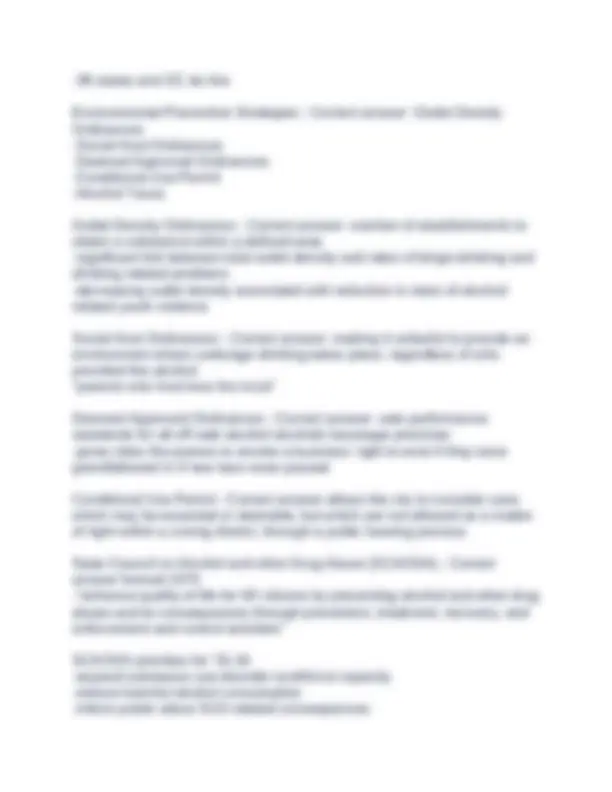
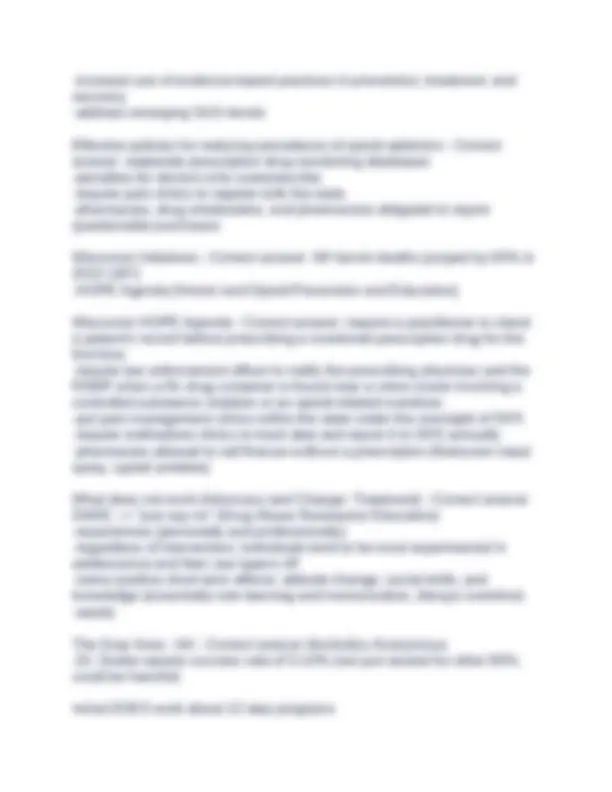
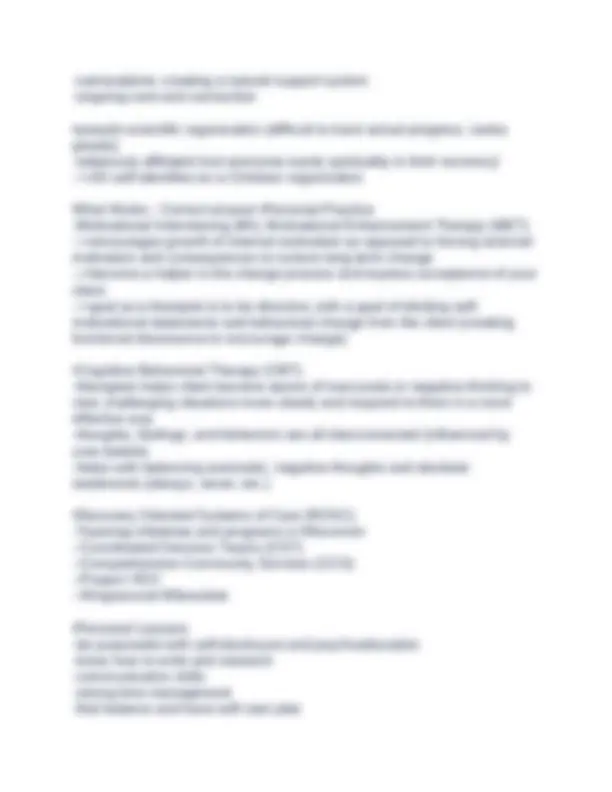
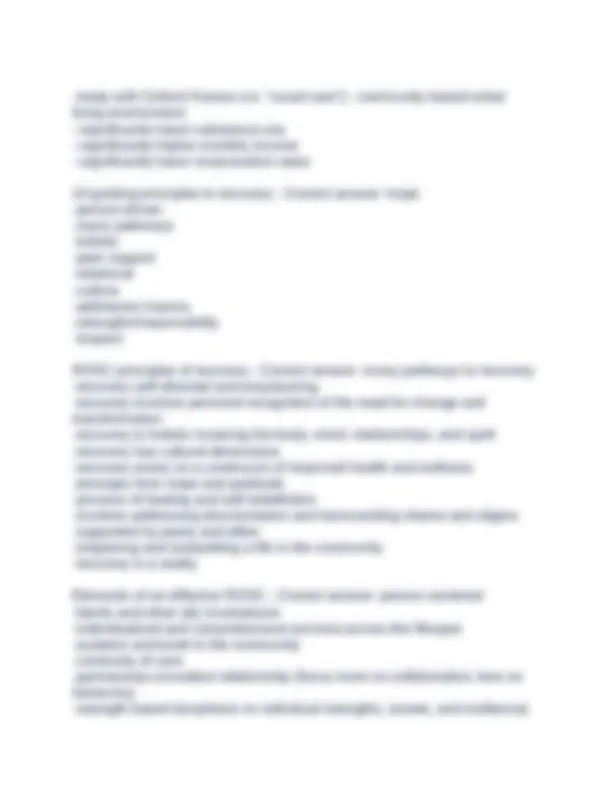
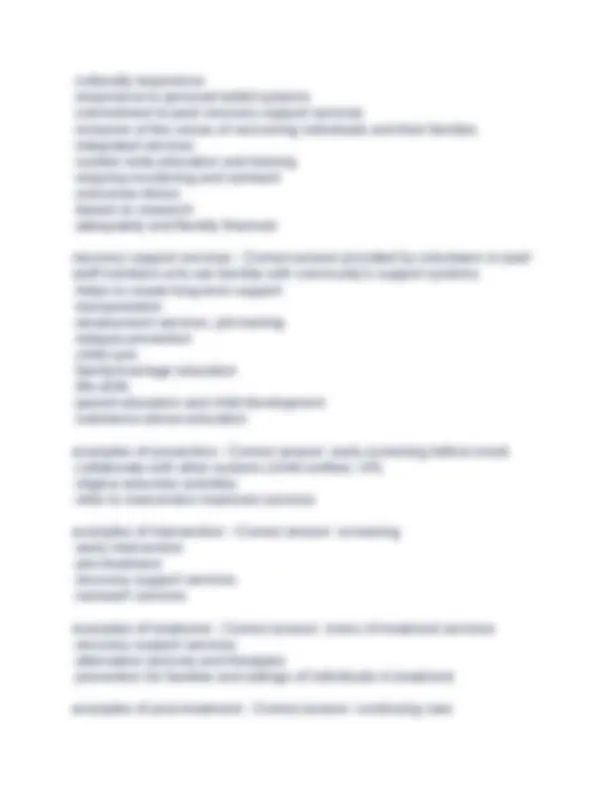
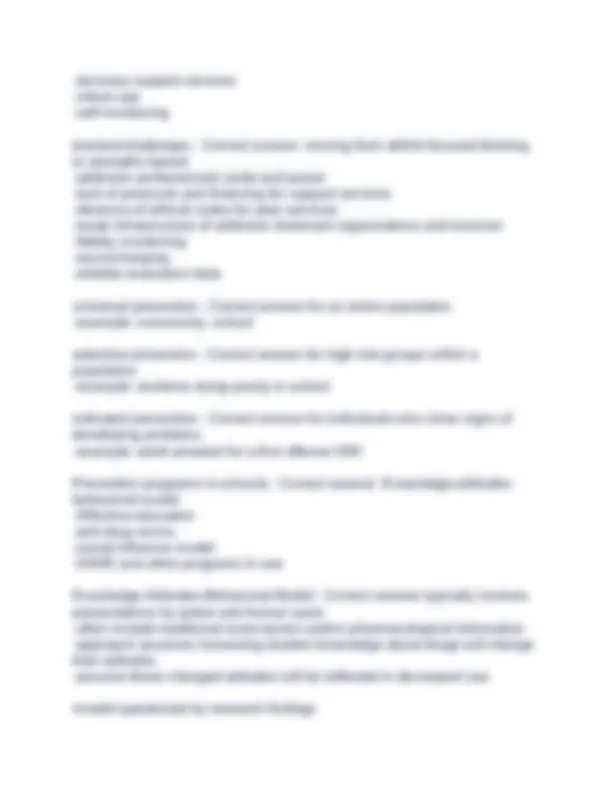
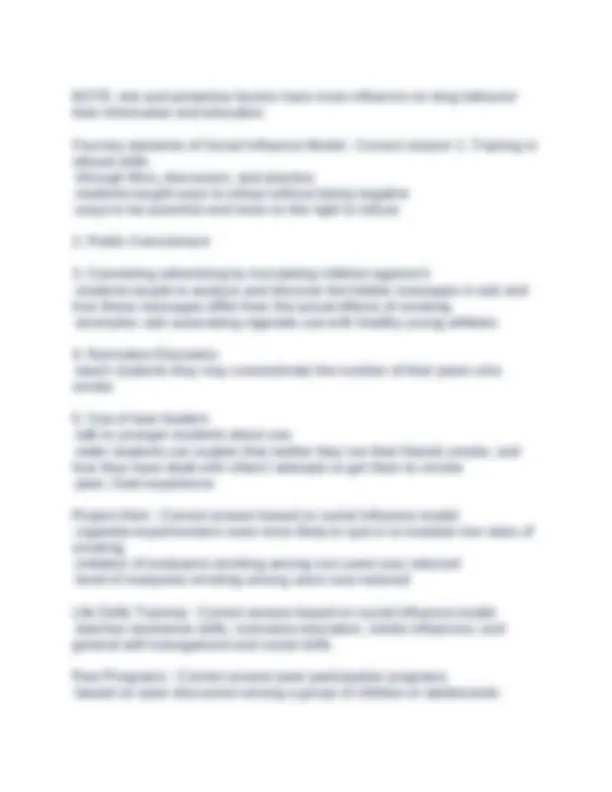
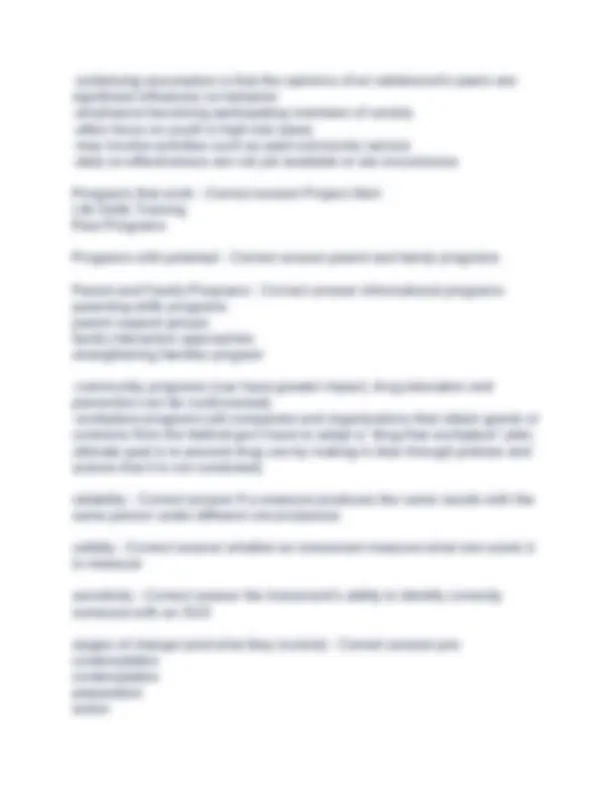
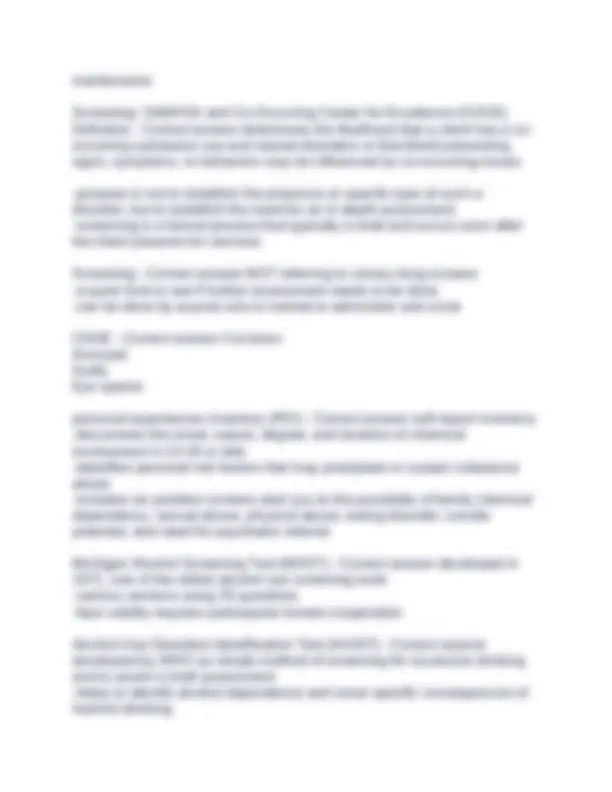
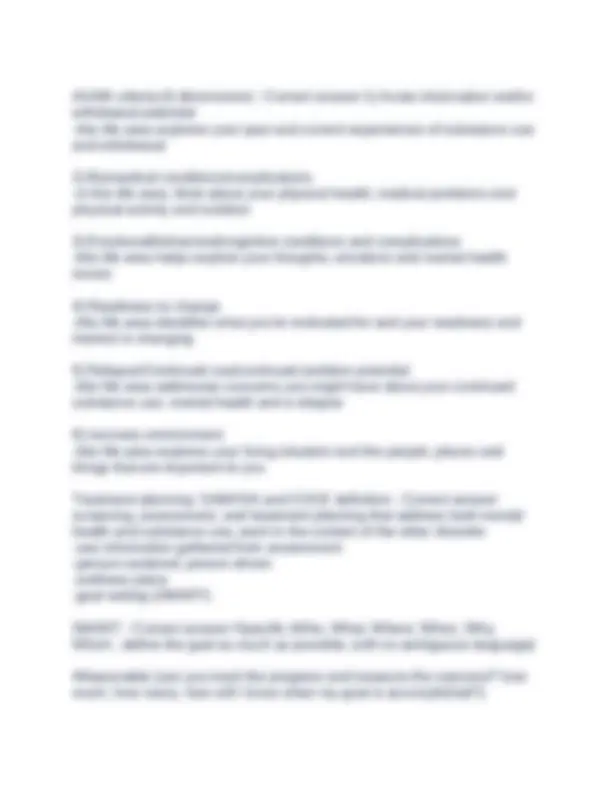
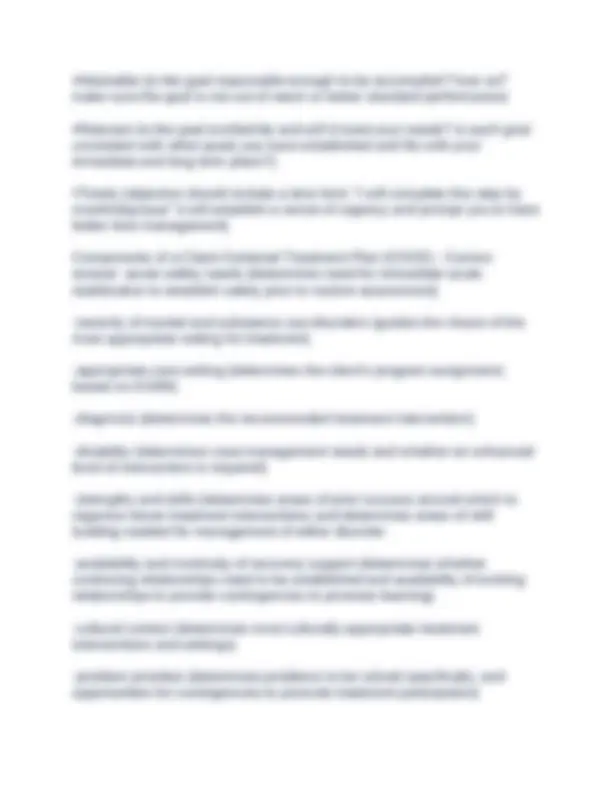
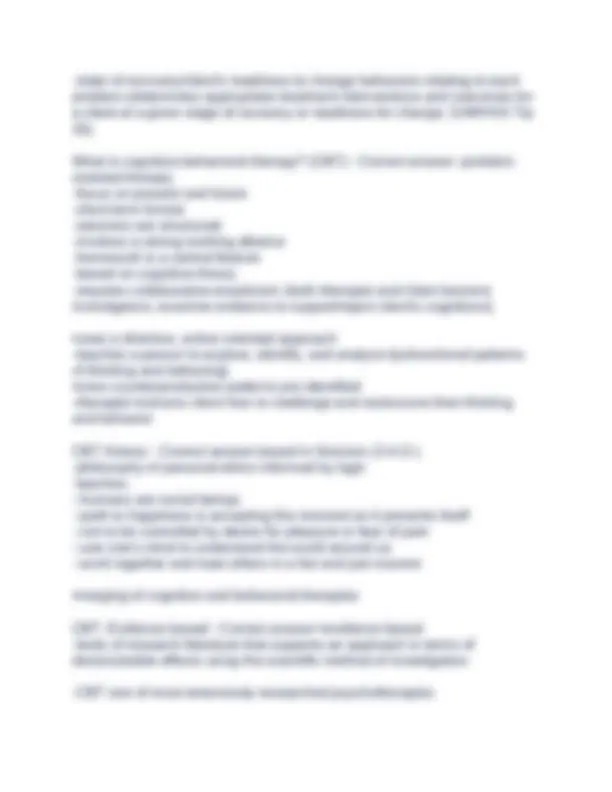
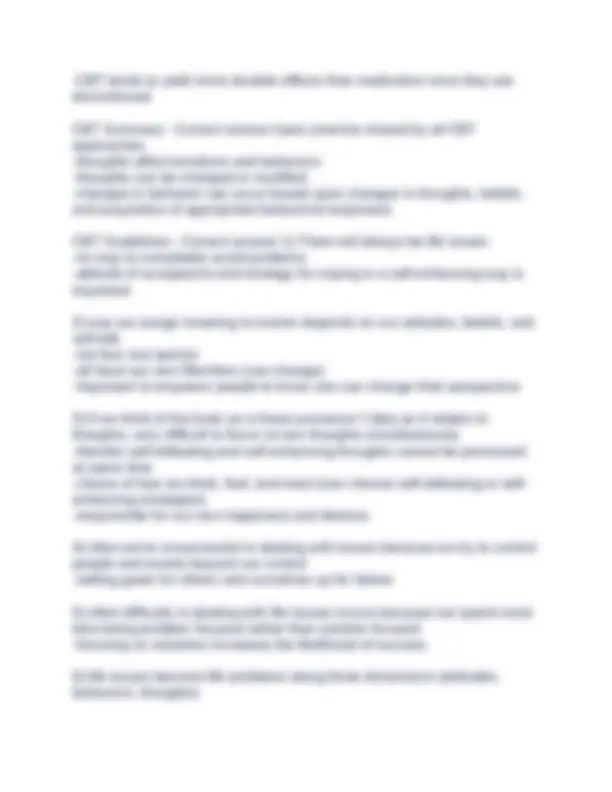
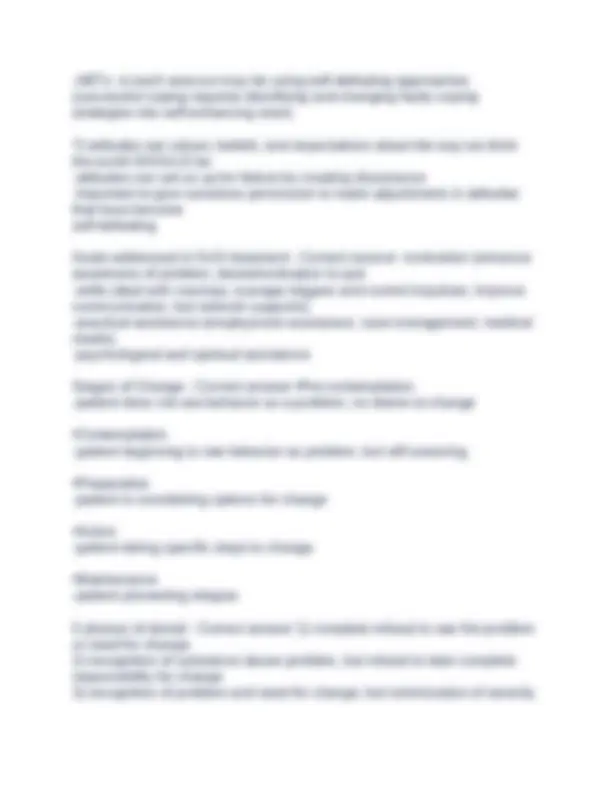
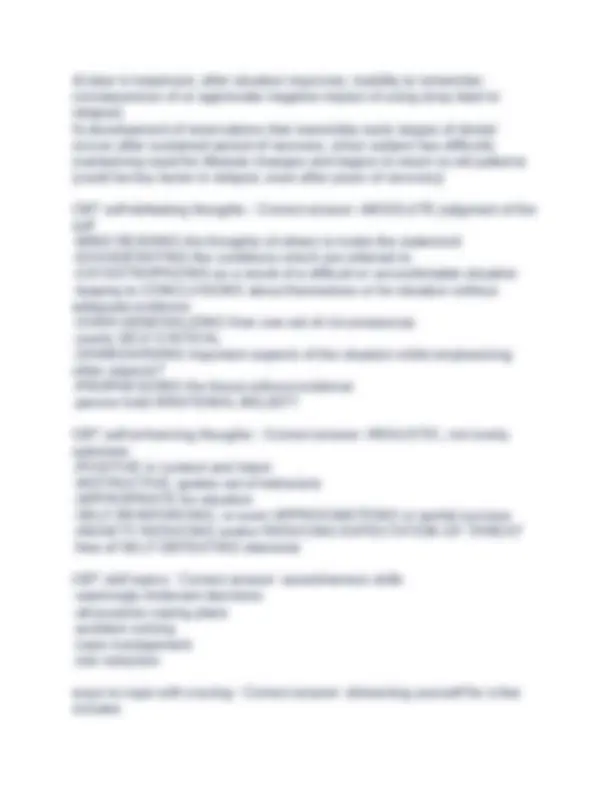
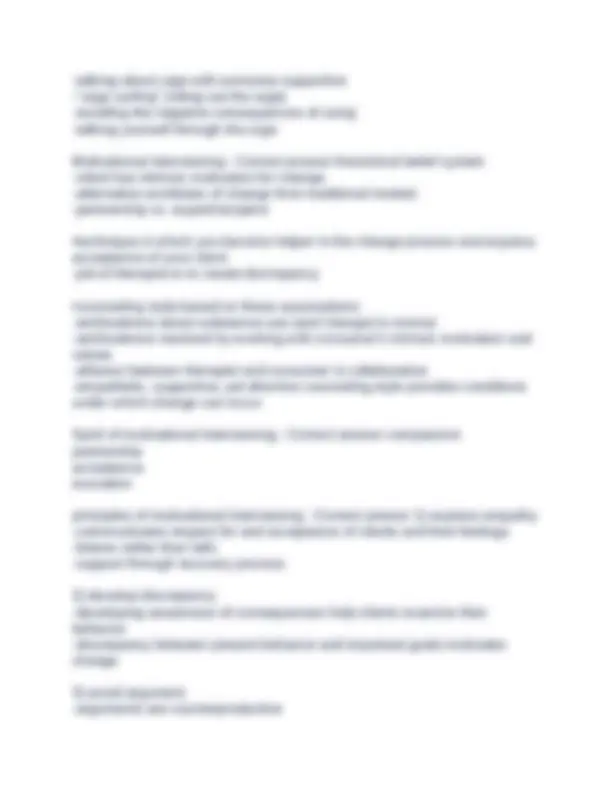
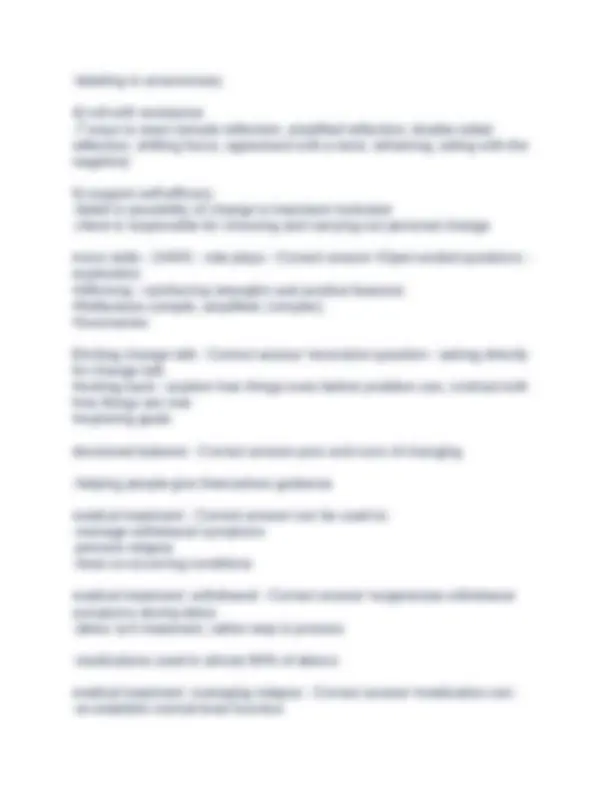
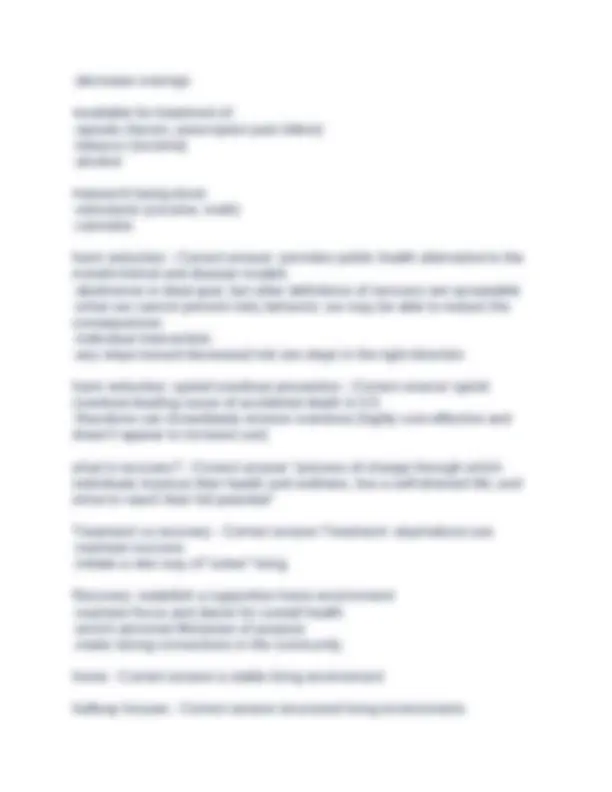
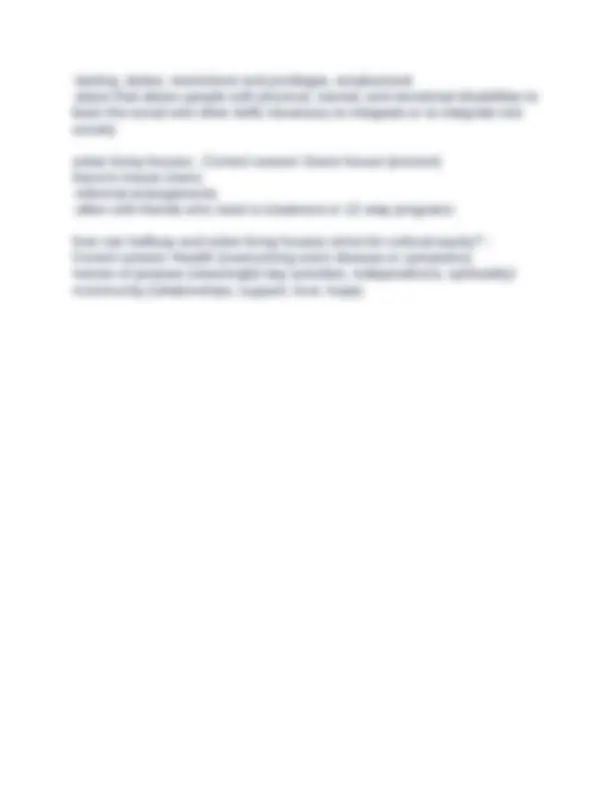


Study with the several resources on Docsity

Earn points by helping other students or get them with a premium plan


Prepare for your exams
Study with the several resources on Docsity

Earn points to download
Earn points by helping other students or get them with a premium plan
Community
Ask the community for help and clear up your study doubts
Discover the best universities in your country according to Docsity users
Free resources
Download our free guides on studying techniques, anxiety management strategies, and thesis advice from Docsity tutors
SPSS Assignment: The One-Sample
Typology: Exams
1 / 27

This page cannot be seen from the preview
Don't miss anything!




















Prevention Paradox - Correct answer the large number of people at small risk contribute more harm/costs than the smaller number of people who are individually at greater risk primary prevention - Correct answer -prevent use before it starts -aimed primarily at younger people -health promotion and addressing risk factors, social and genetic factors secondary prevention - Correct answer -curtail further problematic or risky use -prevent addiction and disorder -aimed at persons who have used substances -screening of at risk individual -control of risk factors and early intervention tertiary prevention - Correct answer -intervention, treatment, recovery -aimed at people who have developed substance use disorders -rehabilitation, preventing complications and improving quality of life social influence model - Correct answer -it's possible to design effective smoking prevention programs -presenting information about the delayed consequences of smoking (like lung cancer) is relatively ineffective -presenting information on immediate effects (like shortness of breath) is more effective •training in refusal skills (through films, discussions, and practice), assertiveness (ways to refuse without being negative) •counter advertising: analyze and discover hidden messages in ads and how messages differ from actual effects •normative education - teach students they may overestimate the number of their peers who use
•use of peer leaders - to talk to others about use, own experiences, and to teach skills Four A's in Substance use policy change - Correct answer •Availability - how easy is it to access? •Affordability •Acceptability - social perception of use •Attractiveness - for both the product and associating attractiveness of the self when using the product Three Strategies other states use - Correct answer 1) Drinking age of 21 for bars and restaurants
-increase use of evidence-based practices in prevention, treatment, and recovery -address emerging SUD trends Effective policies for reducing prevalence of opioid addiction - Correct answer -statewide prescription drug monitoring databases -penalties for doctors who overprescribe -require pain clinics to register with the state -pharmacies, drug wholesalers, and pharmacists obligated to report questionable purchases Wisconsin Initiatives - Correct answer -WI heroin deaths jumped by 50% in 2012 (187) -HOPE Agenda (Heroin and Opioid Prevention and Education) Wisconsin HOPE Agenda - Correct answer -require a practitioner to check a patient's record before prescribing a monitored prescription drug for the first time -require law enforcement officer to notify the prescribing physician and the PDMP when a Rx drug container is found near a crime scene involving a controlled-substance violation or an opioid-related overdose -put pain management clinics within the state under the oversight of DHS -require methadone clinics to track data and report it to DHS annually -pharmacies allowed to sell Narcan without a prescription (Naloxone nasal spray, opioid antidote) What does not work (Advocacy and Change: Treatment) - Correct answer DARE --> "just say no" (Drug Abuse Resistance Education) -experiences (personally and professionally) -regardless of intervention, individuals tend to be most experimental in adolescence and then use tapers off -some positive short-term effects: attitude change, social skills, and knowledge (essentially rote learning and memorization, decays overtime) -needs The Gray Area - AA - Correct answer Alcoholics Anonymous -Dr. Dodes reports success rate of 5-10% (not just neutral for other 90%, could be harmful) •what DOES work about 12 step programs
-camaraderie, creating a natural support system -ongoing care and connection •pseudo-scientific organization (difficult to track actual progress, varies greatly) -religiously affiliated (not everyone wants spirituality in their recovery) -->AA self-identifies as a Christian organization What Works - Correct answer •Personal Practice -Motivational Interviewing (MI), Motivational Enhancement Therapy (MET) -->encourages growth of internal motivation as opposed to forcing external motivation and consequences to nurture long-term change -->become a helper in the change process and express acceptance of your client -->goal as a therapist is to be directive, with a goal of eliciting self- motivational statements and behavioral change from the client (creating functional dissonance to encourage change) •Cognitive Behavioral Therapy (CBT) -therapists helps client become aware of inaccurate or negative thinking to view challenging situations more clearly and respond to them in a more effective way -thoughts, feelings, and behaviors are all interconnected (influenced by core beliefs) -helps with balancing automatic, negative thoughts and absolute statements (always, never, etc.) •Recovery Oriented Systems of Care (ROSC) -Teaming initiatives and programs in Wisconsin --Coordinated Services Teams (CST) --Comprehensive Community Services (CCS) --Project YES! --Wraparound Milwaukee •Personal Lessons -be purposeful with self-disclosure and psychoeducation -know how to write and research -communication skills -strong time management -find balance and have self-care plan
-accessible services that engage and retain people seeking recovery -continuum of services rather than crisis-oriented care -care that's appropriate for the individuals unique needs -where possible, care in the person's community and home using natural supports What is informing ROSC? - Correct answer -SAMHSA's commitment to person-centered approach -increased involvement in grassroots organizations (gives many pathways to recovery) -current research -changing norms and expectations of services -transformation in the mental health field -emerging and energized recovery community -key leadership at state level -SAMHSA's commitment to providing a life in the community for everyone According to the Institute of Medicine (IOM) Healthcare should be: - Correct answer -safe (avoiding injuries to patients) -effective (providing services based on science) -patient-centered (providing respectful and responsive care) -timely (reducing waiting and delays) -efficient (avoiding waste) -equitable Research supporting ROSC - Correct answer •Chronic care model -based on the assumption that improvement requires interventions on all levels (patient, provider, system) -used in primary medicine for disease management (SUDs are a disease) •Acute care model -short term -generally one visit -problem/solution focused -example: crisis intervention or an ER visit -use of a chronic care model is associated with cost savings -for those with low recovery capital and high disease severity, social supports are critically important for long-term recovery -comprehensive services assist recovery (including peer support services)
-study with Oxford Houses (vs. "usual care") - community based sober living environment --significantly lower substance use --significantly higher monthly income --significantly lower incarceration rates 10 guiding principles to recovery - Correct answer -hope -person-driven -many pathways -holistic -peer support -relational -culture -addresses trauma -strengths/responsibility -respect ROSC principles of recovery - Correct answer -many pathways to recovery -recovery self-directed and empowering -recovery involves personal recognition of the need for change and transformation -recovery is holistic involving the body, mind, relationships, and spirit -recovery has cultural dimensions -recovery exists on a continuum of improved health and wellness -emerges from hope and gratitude -process of healing and self-redefinition -involves addressing discrimination and transcending shame and stigma -supported by peers and allies -(re)joining and (re)building a life in the community -recovery is a reality Elements of an effective ROSC - Correct answer -person-centered -family and other ally involvement -individualized and comprehensive services across the lifespan -systems anchored in the community -continuity of care -partnership-consultant relationship (focus more on collaboration, less on hierarchy) -strength-based (emphasis on individual strengths, assets, and resilience)
-recovery support services -check-ups -self-monitoring barriers/challenges - Correct answer -moving from deficit-focused thinking to strengths-based -addiction professionals' pride and power -lack of protocols and financing for support services -absence of ethical codes for peer services -weak infrastructure of addiction treatment organizations and turnover -fidelity monitoring -record keeping -reliable evaluation data universal prevention - Correct answer for an entire population -example: community, school selective prevention - Correct answer for high-risk groups within a population -example: students doing poorly in school indicated prevention - Correct answer for individuals who show signs of developing problems -example: adult arrested for a first offense OWI Prevention programs in schools - Correct answer -Knowledge-attitudes- behavioral model -Affective education -anti-drug norms -social influence model -DARE and other programs in use Knowledge-Attitudes-Behavioral Model - Correct answer typically involves presentations by police and former users -often include traditional scare tactics and/or pharmacological information -approach assumes increasing student knowledge about drugs will change their attitudes -assume these changed attitudes will be reflected in decreased use •model questioned by research findings
-students with more knowledge about drugs tend to have more positive attitudes about drug use -all early prevention approaches (effective in increasing knowledge about drugs, ineffective in altering attitudes or behaviors) •research on early drug prevention education efforts -students more likely to experiment with drugs -less likely to develop abuse problems Affective Education - Correct answer •focuses on emotions and attitudes (use as a pursuit of excitement, relaxation, power, control, or response to peer pressure) •use may be reduced by early intervention (to know and express their feelings, to achieve altered emotional states without drugs, to feel valued and accepted) •values clarification -assumes students have factual information about drugs (what they lack is ability to make appropriate information based on the information they have) -What is taught: --recognizing and expressing feelings and beliefs --decision making skills --how to analyze and clarify their own values -parents may not understand this approach as it may run contrary to the set of values they want their kids to learn Affective education (continued) - Correct answer •alternative to drugs -assumes one reason young people take drugs is for the experience of altered states of consciousness -teaches other ways of obtaining a high (relaxation, meditation, exercise, sports) -alternatives need to be realistic and tailored to the individual •personal and social skills -assumes personal and social problems are caused by drug use -teaches students communication skills and provides opportunities for successful interpersonal interaction -examples: group of students operate a school store, older students tutor younger students
NOTE: risk and protective factors have more influence on drug behavior than information and education Five key elements of Social Influence Model - Correct answer 1. Training in refusal skills -through films, discussion, and practice -students taught ways to refuse without being negative -ways to be assertive and insist on the right to refuse
-underlying assumption is that the opinions of an adolescent's peers are significant influences on behavior -emphasize becoming participating members of society -often focus on youth in high-risk areas -may involve activities such as paid community service -data on effectiveness are not yet available or are inconclusive Programs that work - Correct answer Project Alert Life Skills Training Peer Programs Programs with potential - Correct answer parent and family programs Parent and Family Programs - Correct answer informational programs parenting skills programs parent support groups family interaction approaches strengthening families program -community programs (can have greater impact, drug education and prevention can be controversial) -workplace programs (all companies and organizations that obtain grants or contracts from the federal gov't have to adopt a "drug-free workplace" plan, ultimate goal is to prevent drug use by making it clear through policies and actions that it is not condoned) reliability - Correct answer if a measure produces the same results with the same person under different circumstances validity - Correct answer whether an instrument measure what one wants it to measure sensitivity - Correct answer the instrument's ability to identify correctly someone with an SUD stages of change (and what they involve) - Correct answer pre- contemplation contemplation preparation action
-designed for health care practitioners and a range of health settings, but with suitable instructions it can be self-administered or used by non-health professionals Assessment: SAMHSA and COCE Definition - Correct answer gathers information and engages in a process with the client that enables the provider to establish (or rule out) the presence or absence of a co-occurring disorder -determines the clients readiness for change -identifies client strengths or problem areas that may affect the process of treatment and recovery -engages the client in the development of an appropriate treatment relationship The Assessment Process (COCE) - Correct answer 1. Engage the client
•physiological (breathing, food, water, sex, sleep, homeostasis, excretion) Treatment planning (old way) - Correct answer "one-size fits all" treatment plan •driven by -what is offered by the program -program philosophy •structure -pre-scheduled meetings and groups -pre-packaged, available services •variation -most treatment plans within a treatment program look the same Treatment planning (new way) - Correct answer individualized treatment plan •driven by -what someone needs -individual's desire, "person-centered" •structure -meetings and groups as a tool to meet specific needs -range of needed services, within the clinic and/or community •variation -most treatment plans within a treatment program look different Child and adolescent needs and strengths (CANS) - Correct answer about the "what" not the "why" -snapshot of where the person is when the CANS is completed •lower numbers = better -needs --0 = no evidence of need --3 = immediate/intensive action needed -strengths --0 = centerpiece strength --3 = no strength identified
•Attainable (is the goal reasonable enough to be accomplish? how so? make sure the goal is not out of reach or below standard performance) •Relevant (is the goal worthwhile and will it meet your needs? is each goal consistent with other goals you have established and fits with your immediate and long term plans?) •Timely (objective should include a time limit.."I will complete this step by month/day/year" it will establish a sense of urgency and prompt you to have better time management) Components of a Client-Centered Treatment Plan (COCE) - Correct answer -acute safety needs (determines need for immediate acute stabilization to establish safety prior to routine assessment) -severity of mental and substance use disorders (guides the choice of the most appropriate setting for treatment) -appropriate care setting (determines the client's program assignment, based on ASAM) -diagnosis (determines the recommended treatment intervention) -disability (determines case management needs and whether an enhanced level of intervention is required) -strengths and skills (determines areas of prior success around which to organize future treatment interventions and determines areas of skill building needed for management of either disorder -availability and continuity of recovery support (determines whether continuing relationships need to be established and availability of existing relationships to provide contingencies to promote learning) -cultural context (determines most culturally appropriate treatment interventions and settings) -problem priorities (determines problems to be solved specifically, and opportunities for contingencies to promote treatment participation)
-state of recovery/client's readiness to change behaviors relating to each problem (determines appropriate treatment interventions and outcomes for a client at a given stage of recovery or readiness for change, SAMHSA Tip
What is cognitive-behavioral therapy? (CBT) - Correct answer -problem- oriented therapy -focus on present and future -short-term format -sessions are structured -involves a strong working alliance -homework is a central feature -based on cognitive theory -requires collaborative empiricism (both therapist and client become investigators, examine evidence to support/reject client's cognitions) •uses a directive, action-oriented approach -teaches a person to explore, identify, and analyze dysfunctional patterns of thinking and behaving) •once counterproductive patterns are identified -therapist instructs client how to challenge and restructure their thinking and behavior CBT History - Correct answer based in Stoicism (3 A.D.) -philosophy of personal ethics informed by logic -teaches: --humans are social beings --path to happiness is accepting this moment as it presents itself --not to be controlled by desire for pleasure or fear of pain --use one's mind to understand the world around us --work together and treat others in a fair and just manner •merging of cognitive and behavioral therapies CBT: Evidence-based - Correct answer •evidence-based -body of research literature that supports an approach in terms of demonstrable effects using the scientific method of investigation -CBT one of most extensively researched psychotherapies